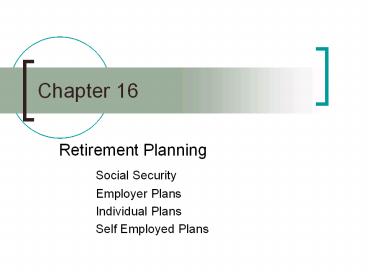Retirement%20Planning - PowerPoint PPT Presentation
Title:
Retirement%20Planning
Description:
Chapter 16 Retirement Planning Social Security Employer Plans Individual Plans Self Employed Plans – PowerPoint PPT presentation
Number of Views:150
Avg rating:3.0/5.0
Title: Retirement%20Planning
1
Chapter 16
- Retirement Planning
- Social Security
- Employer Plans
- Individual Plans
- Self Employed Plans
2
Save Now, Retire Later
3
Save Now, Retire Later
4
Financing Social Security
- FICA deduction on your pay check today is
providing benefits for todays retirees and not
being saved up for your retirement. - Changes will be necessary, possibly increasing
the retirement age or limiting benefits for the
wealthy in order for you to receive anything.
5
Social Security Benefits
- Amount of benefit is determined by
- Number of earnings years
- Average level of earnings
- Adjustments for inflation
- Born prior to 1937 receive full benefits at age
65. - Born after 1960 receive full benefits at age 67.
6
Defined Benefit PlanPension
- Employee receives a promised or defined payout
at retirement. - Usually funded by the employer and the employee
does not pay into the plan. - Payout is based on age at retirement, salary
level, and years of service.
7
Defined Contribution Plan401k
- Employer (usually a match) and the employee
contribute directly to an individual account set
aside for the employee. - It is like a personal savings account but your
eventual payments are not guaranteed. - What you receive depends on how much is
contributed and how well the account investments
perform.
8
401(k) Plans
- Contributions are before tax .
- In 2006, contributions set at 15,000
- Thereafter, indexed annually for inflation.
- Taxes on earnings are deferred until withdrawn.
- Employer offers variety of investment choices.
- Withdrawls are fully-taxable.
9
Individual Retirement Accounts (IRAs)
- Traditional IRA Contributions
- Fully tax deductible
- Before tax
- Partially tax deductible
- Not tax deductible
- After tax
- Roth IRA Contributions
- Not tax deductible
- After tax
10
Traditional IRAs
- Contributions may be tax deductible in whole or
in part. - In 2005-2007, contributions set at 4000 in
2008, it climbs to 5000. - Taxes on earnings are deferred until withdrawn.
11
The Roth IRA
- Contributions are not tax deductible (after tax
). - In 2005-2007, contributions set at 4000
- In 2008, it climbs to 5000.
- Taxes are not due on the earnings. Its an
exclusion. - Therefore, no tax is due on withdrawls.
12
Roth Versus Tradiational IRA Which is Best for
You?
- Choose the Roth IRA if you can afford to pay your
taxes now or if you expect tax rates to increase
in the future. - Although it is possible to end up with the same
amount to spend at retirement, it would require
investing the initial tax savings on the
Traditional IRA contribution and assuming a
constant tax rate.
13
Roth Versus Traditional IRA
Example
- Assume a 30 constant tax rate and a 10 return
for 40 years (FV factor 45.26) - You need 5,714 (pretax) to make a 4,000 (after
tax) Roth contribution and would end up with
181,040 and NO TAXES due on the withdrawl of
this money. - You need 4,000 (after tax but take adjustment)
to fund a Traditional IRA and would still end up
with 181,040, but after taxes of 30, you would
only receive 126,728 unless you took the 1,200
tax savings from the adjustment and invested it
in a tax-exempt bond earning 10.
14
Retirement Plans for Self Employed and
Small Business
- Keogh Plans
- SEP - Simplified Employee Pension
- SIMPLE - Savings Incentive MatchPlan for
Employees
15
Save Now, Retire Later
- Step 1 Set goals.
- Step 2 Estimate income you need.
- Step 3 Estimate your income available.
- Step 4 Calculate shortfall.
- Step 5 Calculate the funds needed to cover this
shortfall. - Step 6 Calculate annual savings needed.
- Step 7 Put the plan into play and save.































